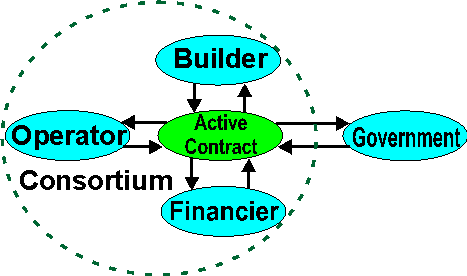Active Contracts for BOT
An Active Contract addresses many of the problems in developing and maintaining a BOT contract. Each of the parties to the bid can contribute their expertise in a way that can be communicated in an active form to the other parties. Each of the parties can mesh the Active Contract with their enterprise policies and their current risk profiles to assess whether the deal fits with their present goals.
| The builder can put forward technology options, detail the construction risk in all its complexity, indicate the maintenance load and the staffing levels for the design. | |
| The operator can estimate the revenue stream, the risk to reputation for completion delays and teething troubles, the cost of maintenance and staffing. | |
| The financier can contribute the cost of money, the economic outlook as it might impact on revenue, the possibility of floating the business once construction and startup commercial risk are behind it. | |
| The contributions from the parties are held in a web of commercial and legal constraints. | |
| When the government or other client accepts the bid, the Active Contract can be used to describe its obligations and responsibilities as they change over the life of the contract. |
Many of these contributions interact – the technology used influences the cost of construction and time to completion, but also the quality of the asset. A well-proven technology may seem an easier option, but may become obsolescent well before the time to transfer the asset, leading to shutdown and expensive refurbishment during the life of the contract. A new technology may introduce barely acceptable design, completion and reliability risks.

Active Contract – What It Offers
Tupai’s Active Contract provides a platform that is easily used by each of the parties. Graphics based tools are provided to build and alter the active structure forming the contract. The tools that the different parties use to work on the contract suit the view that each party has of the project.
The builder can construct a highly flexible project plan, involving alternative plant technologies and construction methods. Costs, construction times, types of resources, all can be variable and made dependent on the contributions of the other parties. The builder can embed his expertise in the plan, using distributions and correlations on time, cost, risk that embody his experience and analysis.
The operator can describe the ramping up of the revenue stream in detail, the startup costs, the fallback strategy if production or revenue targets are not met.
The financier can describe the financing strategy for the project, the initial availability of funds, the cost of funds over the contract life. Various metrics, such as ROI, can be made to actively control the project to force it to meet certain hurdles, rather than just be a measure of what the outcome should be.
The government or other client can describe the constraints they wish to impose on the project, and the support they will give if their projections for the ROI of the asset prove inaccurate.
The Active Contract carries its activity within itself – it can appear as the consortium to the client, and can appear as the other parties to any member of the consortium. This allows each of the parties to explore different scenarios and evaluate their risk in comparison to the risk borne by the other parties.
Simulations of different scenarios can be run at any level – for a single party, the consortium, the whole system. Any weaknesses found can be addressed, new structure added to change or shift risk, and simulations redone. The active structure can be passed to the other parties, who can verify for themselves what they are being told, or seek alternative solutions to a particular problem. Parts of the structure that comprises the Active Contract can be "black-boxed" to retain commercial in confidence among the parties.
Tupai’s technology confers many advantages when handling complex contracts:
| It combines the modeling of time, cost, risk and responsibility together – something can vary in how much it costs, how long it will take, whether it happens at all. | |
| It allows the melding of historical and hypothetical risk, an essential ingredient when setting out to do something that is even slightly different to what has gone before. | |
| The legal framework for the contract and all the inbuilt protection clauses become part of an active structure, ready to exercise control whenever the conditions arise. | |
| It allows each of the parties to couple the contract to itself – to check that its policy and goals are compatible with the contract without allowing inconsistency and misunderstanding to creep in, because each of the parties is using the same active structure. | |
| The Active Contract becomes a dynamic cost and risk allocation during handover from Construction to Operation. | |
| The structure of the contract survives change, so it can be used right from the bid stage through complex negotiations all the way to the transfer of the asset, keeping alive all the decisions that are made over the life of the contract – not easy to do with a paper-based contract having a twenty or thirty year life. |
BOT contracts have a many-party structure that is different to a prime contractor/subcontractor structure, where one party has control. This many-party structure requires control to be distributed among the parties. The Active Contract, with its activity embedded in the structure, mirrors this distribution of control. It allows more effective contribution of a wide range of expertise to the project and less possibility of misunderstanding of the risks and rewards for all the parties involved.
See